Cloud Computing Project Management Software Peer Reviewed Articles
What is cloud computing, in elementary terms?
Cloud computing is the commitment of calculating services—including servers, storage, databases, networking, software, analytics, and intelligence—over the Internet ("the cloud") to offering faster innovation, flexible resource, and economies of scale.
How does cloud calculating work?
Rather than owning their own computing infrastructure or data centres, companies can rent access to anything from applications to storage from a cloud service provider.
One do good of using cloud-computing services is that firms can avoid the upfront price and complexity of owning and maintaining their own IT infrastructure, and instead merely pay for what they use, when they use it.
In turn, providers of deject-computing services tin benefit from significant economies of calibration past delivering the same services to a wide range of customers.
What cloud-computing services are available?
Deject-calculating services cover a vast range of options now, from the nuts of storage, networking and processing ability, through to natural language processing and artificial intelligence besides as standard office applications. Pretty much whatever service that doesn't require you to be physically shut to the figurer hardware that yous are using can at present exist delivered via the cloud – even quantum computing.
What are examples of cloud calculating?
Cloud computing underpins a vast number of services. That includes consumer services similar Gmail or the cloud backup of the photos on your smartphone, though to the services that permit large enterprises to host all their data and run all of their applications in the cloud. For example, Netflix relies on cloud-computing services to run its its video-streaming service and its other business systems, likewise.
Cloud calculating is becoming the default option for many apps: software vendors are increasingly offering their applications as services over the internet rather than standalone products as they try to switch to a subscription model. However, there are potential downsides to cloud computing, in that it can too introduce new costs and new risks for companies using information technology.
Why is it called cloud computing?
A central concept behind cloud computing is that the location of the service, and many of the details such every bit the hardware or operating system on which information technology is running, are largely irrelevant to the user. It'due south with this in mind that the metaphor of the cloud was borrowed from old telecoms network schematics, in which the public telephone network (and later the internet) was often represented as a cloud to denote that the location didn't matter – information technology was only a cloud of stuff. This is an over-simplification of form; for many customers, location of their services and data remains a key issue.
What is the history of cloud computing?
Cloud computing as a term has been around since the early 2000s, but the concept of calculating equally a service has been around for much, much longer – as far dorsum as the 1960s, when reckoner bureaus would permit companies to rent time on a mainframe, rather than have to buy one themselves.
These 'time-sharing' services were largely overtaken by the ascent of the PC, which made owning a computer much more affordable, and and so in turn past the rising of corporate data centres where companies would store vast amounts of information.
Just the concept of renting access to computing ability has resurfaced again and again – in the application service providers, utility computing, and grid computing of the late 1990s and early on 2000s. This was followed past cloud computing, which really took hold with the emergence of software as a service and hyperscale cloud-calculating providers such as Amazon Web Services.
How important is the cloud?
Edifice the infrastructure to back up cloud computing now accounts for a significant chunk of all Information technology spending, while spending on traditional, in-house It slides as computing workloads continue to move to the cloud, whether that is public cloud services offered by vendors or private clouds built by enterprises themselves.
Indeed, information technology's increasingly clear that when it comes to enterprise computing platforms, like information technology or not, the cloud has won.
Tech annotator Gartner predicts that as much every bit half of spending beyond awarding software, infrastructure software, business organization process services and system infrastructure markets volition have shifted to the cloud past 2025, upward from 41% in 2022. It estimates that almost two-thirds of spending on application software will be via cloud computing, up from 57.vii% in 2022.
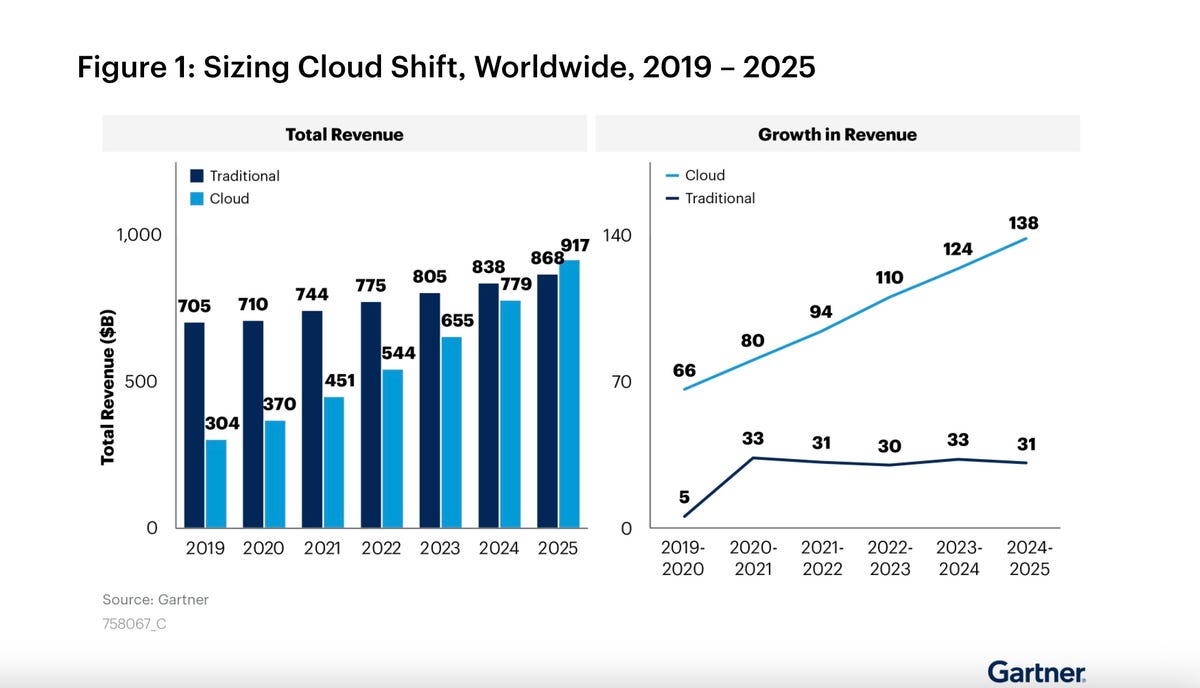
That's a shift that only gained momentum in 2020 and 2021 as businesses accelerated their digital transformation plans during the pandemic. The lockdowns throughout the pandemic showed companies how important it was to be able to access their calculating infrastructure, applications and data from wherever their staff were working – and not just from an office.
Gartner said that demand for integration capabilities, active piece of work processes and composable architecture will drive the continued shift to the deject.
The scale of cloud spending continues to rise. For the total year 2021, tech analyst IDC expects cloud infrastructure spending to have grown 8.3% compared to 2020 to $71.8 billion, while non-cloud infrastructure is expected to abound but 1.9% to $58.4 billion. Long term, the analyst expects spending on compute and storage cloud infrastructure to see a compound annual growth rate of 12.4% over the 2020-2025 menstruum, reaching $118.8 billion in 2025, and information technology volition account for 67.0% of total compute and storage infrastructure spend. Spending on non-cloud infrastructure will be relatively flat in comparing and reach $58.6 billion in 2025.
All predictions around cloud-computing spending are pointing in the aforementioned direction, even if the details are slightly different. The momentum they are describing is the aforementioned: tech analyst Canalys reports that worldwide deject infrastructure services expenditure topped $50 billion in a quarter for the first time in Q4 2021. For the full twelvemonth, information technology has cloud infrastructure services spending growing 35% to $191.7 billion
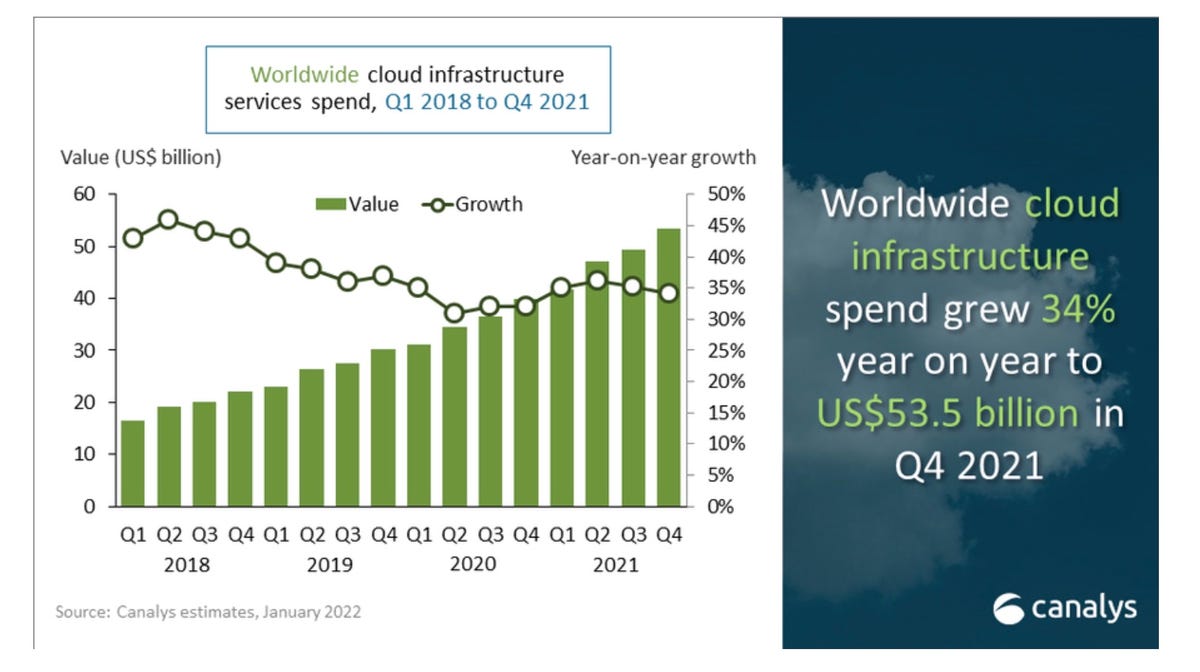
Canalys argues that there is already a new growth opportunity for cloud on the horizon, in the grade of augmented and virtual reality and the metaverse. "This volition be a significant driver for both cloud services spend and infrastructure deployment over the next decade. In many ways, the metaverse will resemble the internet today, with enhanced capabilities and an amplified compute consumption charge per unit," the analyst said.
What are the core elements of cloud calculating?
Cloud calculating can be broken downwardly into a number of dissimilar constituent elements, focusing on unlike parts of the technology stack and different use cases. Let's take a look at some of the best known in a bit more detail.
What is Infrastructure as a Service?
Infrastructure equally a Service (IaaS) refers to the cardinal building blocks of computing that tin can be rented: concrete or virtual servers, storage and networking. This is bonny to companies that desire to build applications from the very footing up and desire to command almost all the elements themselves, but it does crave firms to have the technical skills to be able to orchestrate services at that level.
What is Platform as a Service?
Platform as a Service (PaaS) is the side by side layer upwards – every bit well every bit the underlying storage, networking, and virtual servers, this layer also includes the tools and software that developers need to build applications on height, which could include middleware, database direction, operating systems, and development tools.
What is Software equally a Service?
Software as a Service (SaaS) is the commitment of applications every bit a service, probably the version of deject computing that most people are used to on a day-to-solar day basis. The underlying hardware and operating organization is irrelevant to the terminate user, who will access the service via a spider web browser or app; it is often bought on a per-seat or per-user basis.
SaaS is the largest chunk of cloud spending simply because the variety of applications delivered via SaaS is huge, from CRM such as Salesforce, through to Microsoft's Role 365. And while the whole market place is growing at a furious rate, it's the IaaS and PaaS segments that have consistently grown at much faster rates, co-ordinate to analyst IDC: "This highlights the increasing reliance of enterprises on a cloud foundation built on cloud infrastructure, software-defined information, compute and governance solutions every bit a Service, and cloud-native platforms for application deployment for enterprise IT internal applications." IDC predicts that IaaS and PaaS will continue growing at a higher rate than the overall cloud marketplace "every bit resilience, flexibility, and agility guide Information technology platform decisions".
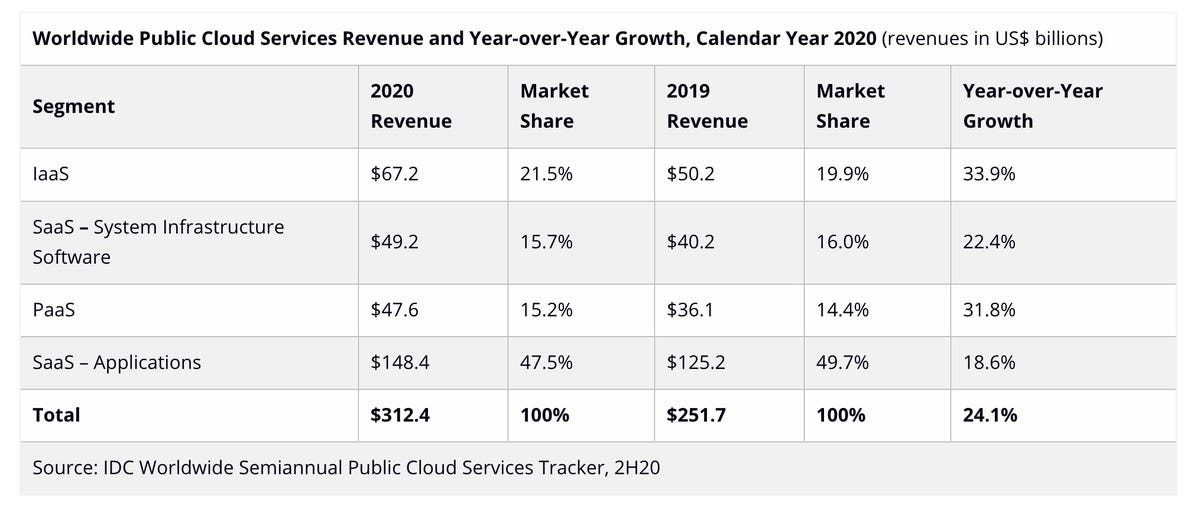
What is multi-deject computing?
While the big cloud vendors would be very happy to provide all the computing needs of their enterprise customers, increasingly businesses are looking to spread the load beyond a number of suppliers. All of this has lead to the ascension of multi-cloud. Role of this approach is to avoid being locked in to just one vendor (which can lead to the sort of high costs and inflexibility that the cloud is oft claimed to avoid), and part of it is to find the best mix of technologies across the industry.
That means being able to connect and integrate deject services from multiple vendors is going to exist a new and increasing claiming for business. Problems here include skills shortages (a lack of workers with expertise across multiple clouds) and workflow differences between cloud environments. Customers will besides want to manage all their unlike cloud infrastructure from one place, make it easy to build applications and services and then motility them, and ensure that security tools can piece of work across multiple clouds – none of which is peculiarly piece of cake right now.
What are the benefits of deject computing?
The exact benefits will vary according to the type of deject service being used but, fundamentally, using deject services means companies non having to buy or maintain their own calculating infrastructure.
No more buying servers, updating applications or operating systems, or decommissioning and disposing of hardware or software when it is out of date, as it is all taken care of by the supplier. For commodity applications, such equally email, information technology can make sense to switch to a cloud provider, rather than rely on in-house skills. A company that specializes in running and securing these services is likely to have better skills and more than experienced staff than a small business could afford to hire, so cloud services may be able to deliver a more than secure and efficient service to end users.
Using deject services means companies can motility faster on projects and test out concepts without lengthy procurement and big upfront costs, considering firms only pay for the resource they consume. This concept of business agility is oft mentioned by cloud advocates as a key benefit. The ability to spin up new services without the time and attempt associated with traditional IT procurement should mean that it is easier to get going with new applications faster. And if a new application turns out to be wildly pop, the elastic nature of the cloud means it is easier to scale information technology up fast.
For a company with an application that has large peaks in usage, such as 1 that is just used at a particular time of the week or year, it might make financial sense to have it hosted in the deject, rather than have dedicated hardware and software laying idle for much of the time. Moving to a cloud-hosted application for services like email or CRM could remove a burden on internal IT staff, and if such applications don't generate much competitive advantage, at that place will exist footling other impact. Moving to a services model also moves spending from capital expenditure (capex) to operational expenditure (opex), which may be useful for some companies.
- Business continuity is the ultimate killer application for cloud
- It's official: Supercomputing is now ho-hum (thank you, deject)
What are the advantages and disadvantages of cloud computing?
Cloud computing is not necessarily cheaper than other forms of computing, only as renting is non always cheaper than buying in the long term. If an awarding has a regular and predictable requirement for calculating services it may be more economical to provide that service in-house.
Some companies may be reluctant to host sensitive information in a service that is too used by rivals. Moving to a SaaS application may also mean you are using the same applications equally a rival, which might make information technology hard to create any competitive advantage if that awarding is core to your business.
While it may exist easy to start using a new cloud application, migrating existing data or apps to the cloud might exist much more complicated and expensive. And it seems there is at present something of a shortage in deject skills, with staff with DevOps and multi-cloud monitoring and management knowledge in particularly short supply.
In 1 report, a significant proportion of experienced cloud users said they idea upfront migration costs ultimately outweigh the long-term savings created by IaaS.
And of course, you can simply access your applications if you lot have an cyberspace connection.
What is deject-computing adoption doing to It budgets?
Cloud computing tends to shift spending from capex to opex, as companies buy computing as a service rather than in the form of concrete servers. This may let companies to avoid large increases in Information technology spending which would traditionally be seen with new projects; using the cloud to make room in the budget might be easier than going to the CFO and looking for more than money.
Of class, this doesn't mean that cloud computing is ever or necessarily cheaper that keeping applications in-house; for applications with a predictable and stable demand for computing power, it might exist cheaper (from a processing ability point of view at least) to keep them in-house.
- Deject calculating spending is growing fifty-fifty faster than expected
How practice you build a business case for cloud computing?
To build a business concern case for moving systems to the cloud, yous first demand to empathise what your existing infrastructure actually costs. There'south a lot to cistron in: obvious things like the price of running information centres, and extras such as leased lines. The cost of physical hardware – servers and details of specifications like CPUs, cores and RAM, plus the cost of storage. You'll too demand to calculate the cost of applications, whether you plan to dump them, re-host them in the deject unchanged, completely rebuilding them for the deject, or buy an entirely new SaaS parcel. Each of these options will have different toll implications. The cloud business case also needs to include people costs (often second only to the infrastructure costs) and more than nebulous concepts like the benefit of being able to provide new services faster. Whatsoever cloud business instance should also factor in the potential downsides, including the chance of being locked into 1 vendor for your tech infrastructure (come across multi-cloud, above).
- Cloud computing: How to build a business concern instance
- Cloud computing: What it's like to brand the motion
Deject-computing adoption
Analysts argue that every bit the deject at present underpins almost new technological disruptions in everything from mobile banking to healthcare, usage is only going abound. It's hard to see many new engineering science projects being delivered that don't harness the cloud in some way. Gartner says that more than than 85% of organizations will embrace a cloud-first principle past 2025 and volition not exist able to fully execute on their digital strategies without it. The analyst says new workloads deployed in a deject-native environment will be pervasive, not just popular, and anything non-deject will be considered legacy. Past 2025, Gartner estimates that over 95% of new digital workloads will exist deployed on cloud-native platforms, up from 30% in 2021.
And if that sounds unrealistic, it may exist that figures on adoption of cloud depend on who you lot talk to inside an organisation. Not all cloud spending will be driven centrally by the CIO: cloud services are relatively piece of cake to sign-up for, and then business managers can commencement using them, and pay out of their own budget, without needing to inform the IT department. This tin enable businesses to move faster, but as well can create security risks if the use of apps is not managed.
Adoption will as well vary by application: cloud-based email is much easier to adopt than a new finance system, for example. And for systems such every bit supply chain management, that are working efficiently equally they are, in that location will be less brusque-term pressure to do a potentially costly and risky shift to the cloud.
What about deject-computing security?
Many companies remain concerned about the security of cloud services, although breaches of security are rare. How secure y'all consider cloud calculating to be will largely depend on how secure your existing systems are. In-firm systems managed by a team with many other things to worry nearly are likely to be more than leaky than systems monitored past a cloud provider's engineers dedicated to protecting that infrastructure.
However, concerns practice remain about security, especially for companies moving their information betwixt many deject services, which has led to growth in deject security tools, which monitor information moving to and from the cloud and between cloud platforms. These tools can place fraudulent use of data in the cloud, unauthorised downloads, and malware. There is a fiscal and performance impact, withal: these tools tin reduce the return on investment of the cloud by v% to 10%, and bear on operation by 5% to 15%. The country of origin of cloud services is likewise worrying some organisations (see 'Is geography irrelevant when it comes to cloud computing?' below)
- Cloud security and IoT are the new peanut butter and jelly
- Azure confidential computing: Microsoft boosts security for deject data
- Three smart cloud services that can assistance keep your business more secure
- Cloud computing security: This is where you'll be spending the money
- Security as a Service? We want it, say IT leaders
What is public cloud?
Public deject is the archetype cloud-calculating model, where users tin access a big pool of computing ability over the net (whether that is IaaS, PaaS, or SaaS). I of the meaning benefits hither is the ability to rapidly scale a service. The cloud-computing suppliers have vast amounts of computing power, which they share out between a large number of customers – the 'multi-tenant' architecture. Their huge scale means they accept plenty spare capacity that they can easily cope if whatever particular customer needs more resource, which is why it is often used for less-sensitive applications that demand a varying amount of resource.
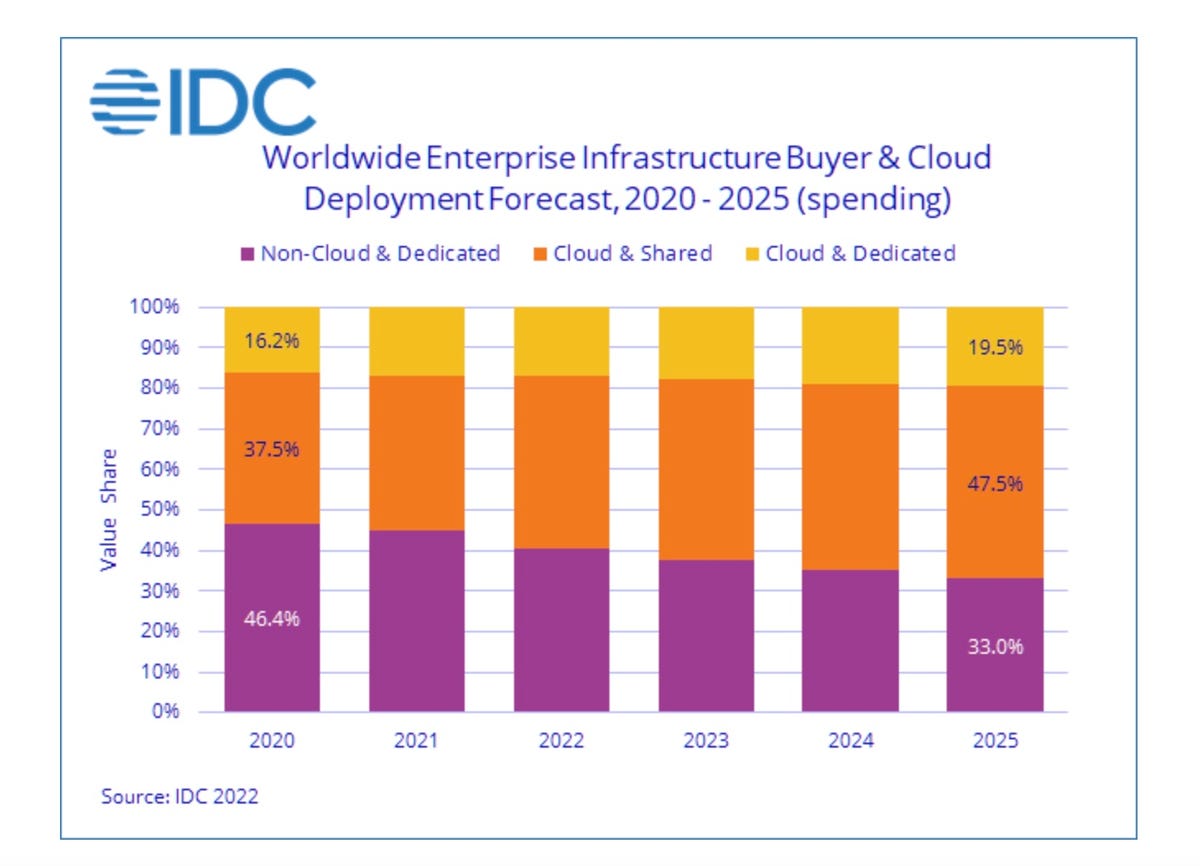
What is private cloud?
Individual deject allows organizations to benefit from some of the advantages of public cloud – but without the concerns about relinquishing control over data and services, because information technology is tucked abroad behind the corporate firewall. Companies can control exactly where their information is being held and can build the infrastructure in a style they want – largely for IaaS or PaaS projects – to give developers access to a pool of calculating power that scales on-demand without putting security at risk. However, that boosted security comes at a toll, every bit few companies will have the scale of AWS, Microsoft or Google, which ways they will not be able to create the same economies of scale. All the same, for companies that require boosted security, private cloud might be a useful stepping stone, helping them to understand cloud services or rebuild internal applications for the cloud, before shifting them into the public cloud.
What are the cloud-computing migration costs?
For startups that plan to run all their systems in the deject, getting started is pretty simple. But the bulk of companies, it is not so unproblematic: with existing applications and data, they need to work out which systems are all-time left running as they are, and which to start moving to cloud infrastructure. This is a potentially risky and expensive move, and migrating to the deject could cost companies more if they underestimate the calibration of such projects.
A survey of 500 businesses that were early deject adopters found that the need to rewrite applications to optimise them for the cloud was one of the biggest costs, particularly if the apps were complex or customised. A 3rd of those surveyed cited high fees for passing data betwixt systems equally a challenge in moving their mission-disquisitional applications. The skills required for migration are both difficult and expensive to detect – and even when organisations could notice the right people, they risked them being stolen away by cloud-computing vendors with deep pockets.
Beyond this, the majority also remained worried nigh the performance of critical apps, and ane in three cited this as a reason for not moving some critical applications.
- Deject calculating migration: More than expensive and complicated than you thought
- Engineering migrations are more painful, and cloud isn't making them any easier
- Where does the NAS fit in an increasingly cloud-centric world?
Is geography irrelevant when it comes to cloud computing?
Actually, it turns out that is where the cloud actually does affair. Geopolitics is forcing significant changes on cloud-computing users and vendors. Firstly, in that location is the issue of latency: if the awarding is coming from a data heart on the other side of the planet, or on the other side of a congested network, and so you might find it sluggish compared to a local connection. That's the latency problem.
Secondly, there is the consequence of data sovereignty. Many companies, specially in Europe, accept to worry about where their data is beingness candy and stored. European companies are worried that, for example, if their customer data is beingness stored in data centres in the US or (owned by US companies), it could exist accessed by Usa law enforcement. Equally a result, the big cloud vendors have been building out a regional data heart network so that organizations can keep their data in their own region.
Some accept gone farther, effectively detatching some of those datacenters from their main business to make it much harder for The states regime – and others – to demand access to the client data stored there. The customer data in the data centres is nether the command of an independent company, which acts every bit a "data trustee", and U.s. parents cannot admission data at the sites without the permission of customers or the information trustee. Wait to meet cloud vendors opening more data centres around the earth to cater to customers with requirements to keep data in specific locations.
Cloud security is another issue; the UK authorities'southward cyber security agency has warned that government agencies need to consider the country of origin when it comes to calculation cloud services into their supply chains. While it was warning almost antivirus software in detail, the consequence is the same for other types of services too.
What is a cloud-computing region? And what is a cloud-computing availability zone?
Cloud-computing services are operated from behemothic datacenters around the globe. AWS divides this upwards by 'regions' and 'availability zones'. Each AWS region is a separate geographic expanse, like Eu (London) or United states W (Oregon), which AWS then farther subdivides into what it calls availability zones (AZs). An AZ is composed of ane or more datacenters that are far enough apart that in theory a single disaster won't take both offline, but close enough together for business organization continuity applications that crave rapid failover. Each AZ has multiple cyberspace connections and ability connections to multiple grids: AWS has over 80 AZs.
Google uses a similar model, dividing its cloud-calculating resources into regions that are then subdivided into zones, which include ane or more datacenters from which customers tin can run their services. It currently over 8 zones: Google recommends customers deploy applications beyond multiple zones and regions to help protect confronting unexpected failures.
Microsoft Azure divides its resources slightly differently. It offers regions that information technology describes equally is a "set of datacentres deployed within a latency-divers perimeter and connected through a dedicated regional low-latency network". It also offers 'geographies' typically containing 2 or more regions, that can exist used past customers with specific data-residency and compliance needs "to keep their data and apps shut". It likewise offers availability zones fabricated up of i or more data centres equipped with independent power, cooling and networking.
Which are the big cloud-computing companies?
When it comes to IaaS and PaaS, there are really only a few behemothic cloud providers. Leading the way is Amazon Web Services, and then the post-obit pack of Microsoft's Azure, Google, and IBM. According to data from Synergy Research, Amazon, Microsoft and Google go on to attract well over half of worldwide cloud spending, with Q3 marketplace shares of 33%, twenty% and 10% respectively. And with growth rates that are higher than the overall market, their share of worldwide revenues continues to grow. Nevertheless, that still leaves plenty of revenue for the chasing pack of companies – about $17 billion. "Clearly there are challenges with the big three companies lurking in the background, and then the name of the game is not competing with them caput on," said the annotator.
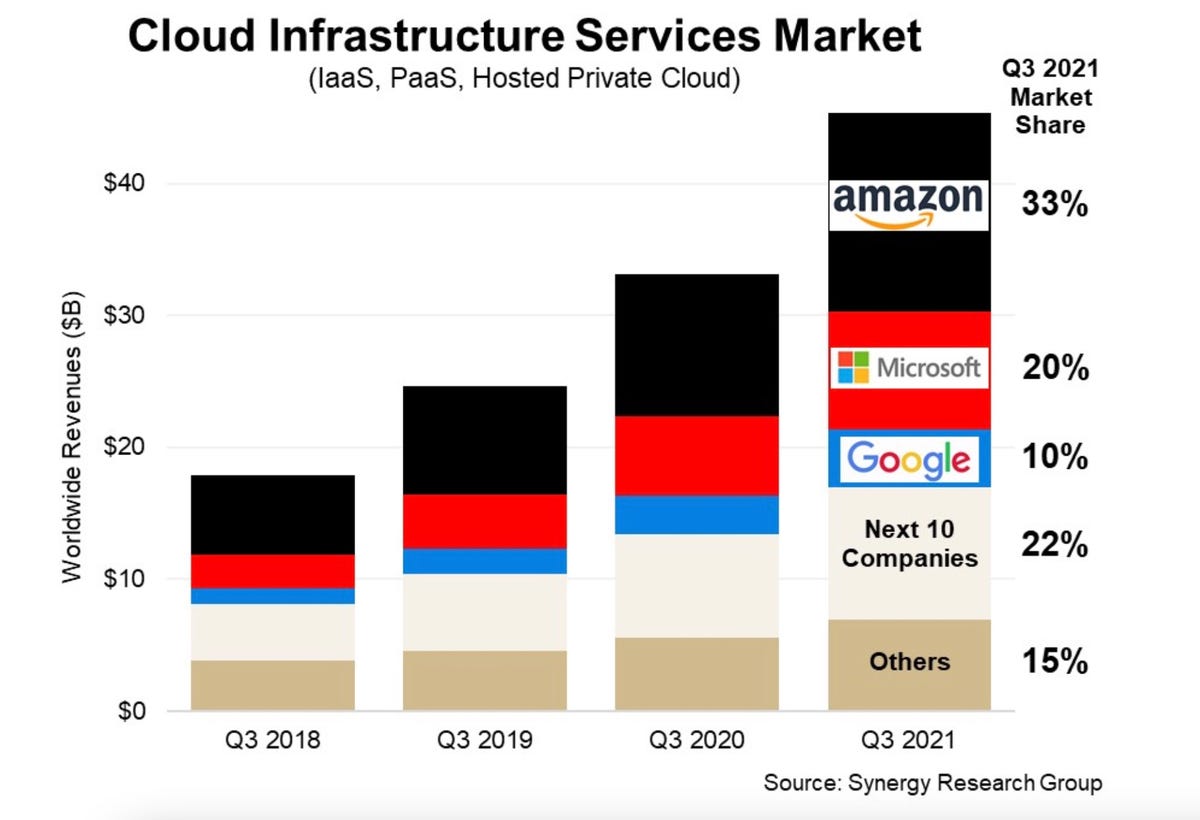
AWS, Azure and Google Cloud – what's the difference?
The big three cloud companies all have their own strengths. AWS is the almost established histrion and was behind Amazon'south ability to back up huge seasonal swings in demand from consumers. Being first out to market with deject services and pushing difficult to gain marketplace share has fabricated it the marketplace leader, and it continues to introduce. Microsoft's Azure has go an admittedly core part of Microsoft's strategy, and the visitor has the enterprise history and products to support businesses every bit they switch to the cloud. Google Deject is the smallest of the big three players, but clearly has the might of the advertisement-to-Android giant backside it.
Who are the other main cloud-computing players?
Beyond the big 3 there are others, such equally Alibaba Cloud, IBM, Dell and Hewlett Packard Enterprise, that all want to be part of the enterprise deject projection. And of grade, from giants like Salesforce down to tiny startups, pretty much every software company is a SaaS company now.
Can cloud computing become wrong?
There are and will continue to exist cloud outages. Those outages might happen at a local level because your internet is disrupted either by concrete means (a digger cuts your broadband) or because of cyberattacks. But the big vendors have outages also and because, we are all increasingly reliant on their services, when the cloud stops, work stops. Few companies have fill-in systems to plough to in this situation. And so long as cloud vendors continue outages to a minimum, then users volition probably consider that using the cloud is more reliable than dwelling-grown apps. Only if outages become widespread, that opinion might alter.
What is the time to come of deject computing?
Cloud calculating is reaching the signal where it is likely to account for more than of enterprise tech spending than the traditional forms of delivering applications and services in-business firm that have been around for decades. However, use of the cloud is only probable to climb as organisations get more comfortable with the idea of their information beingness somewhere other than a server in the basement. And now cloud-computing vendors are increasingly pushing deject computing every bit an amanuensis of digital transformation instead of focusing simply on cost. Moving to the cloud can aid companies rethink business concern processes and accelerate business change, goes the argument, by helping to break down data any organisational silos. Some companies that need to boost momentum around their digital transformation programmes might observe this argument appealing; others may find enthusiasm for the deject waning every bit the costs of making the switch add upward.
- Why yous're however scared of the Deject (information technology'southward not almost security or reliability)
- Cloud calculating switch equally digital transformation takes priority
- Moving to the cloud? Some advice to consider
Deject-computing case studies
At that place are plenty of examples of organisations deciding to go down the cloud-calculating road: here are a few examples of contempo announcements.
- What's the best mode to brand the most of the cloud?
- The states Air Strength plots It overhaul, aims for cloud
- DuluxGroup paints a futurity of procurement in the deject
- Marketo to drift to Google Cloud every bit role of multi-twelvemonth deal
- AWS infrastructure is now behind 3 chief streaming media providers
- American Airlines to movement consumer-facing apps to IBM Cloud, says Deject Foundry cardinal
Previous coverage
The Art of the Hybrid Cloud
Deject computing is gobbling upwards more of the services that power businesses. But, some have privacy, security, and regulatory demands that preclude the public cloud. Hither's how to observe the right mix.
Public cloud, private cloud, or hybrid cloud: What'south the difference?
Trying to understand and articulate the differences between public, individual, and hybrid cloud? Here's a quick breakup.
Read more on cloud computing
- Three smart deject services that can assistance go on your business more secure
- Public deject, individual deject, or hybrid cloud: What's the divergence?
- What does 'hybrid cloud' hateful? It depends on whom y'all enquire
- Infographic: Companies are turning to hybrid cloud to save money
- Businesses will spend $128 billion on public cloud this year, says IDC
- Cloud computing security: This is where you'll be spending the money
Source: https://www.zdnet.com/article/what-is-cloud-computing-everything-you-need-to-know-about-the-cloud/